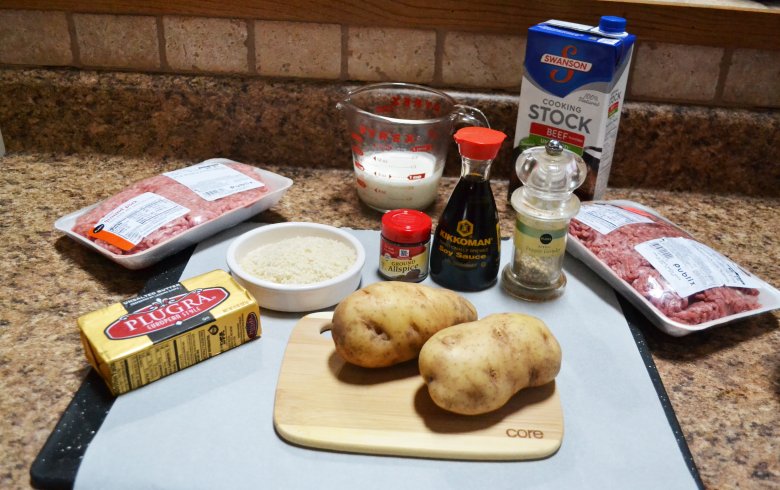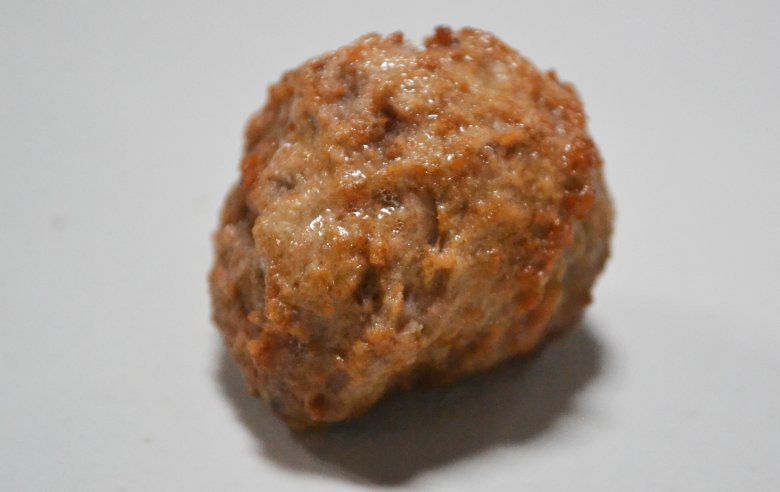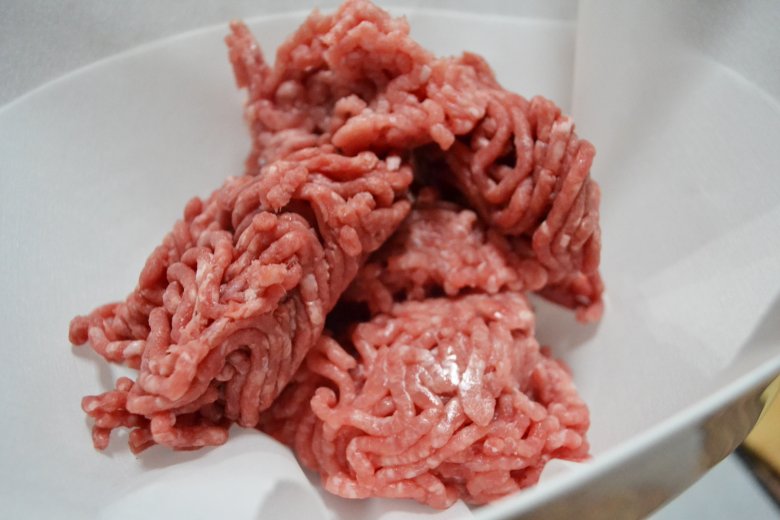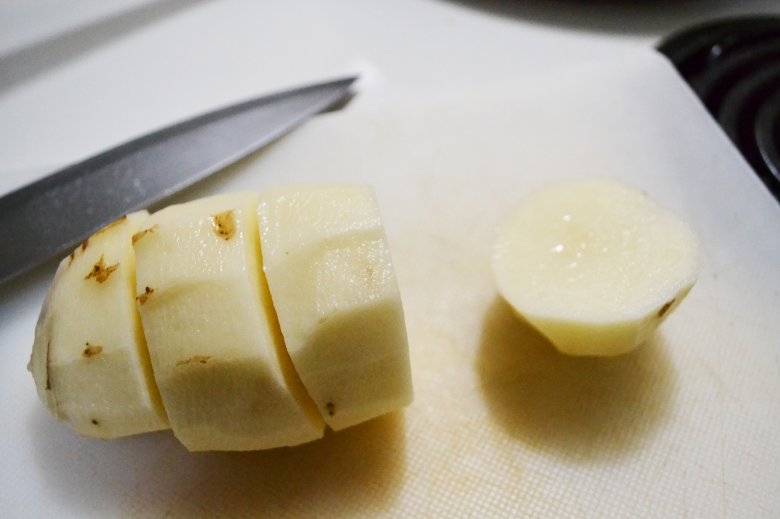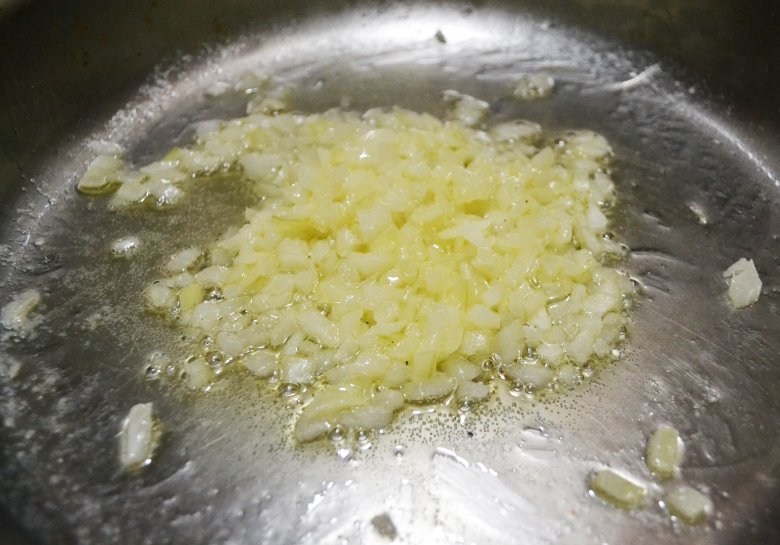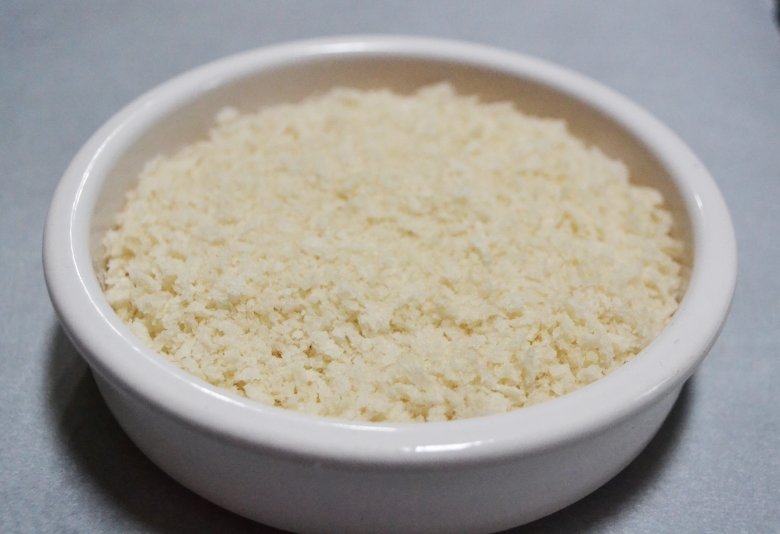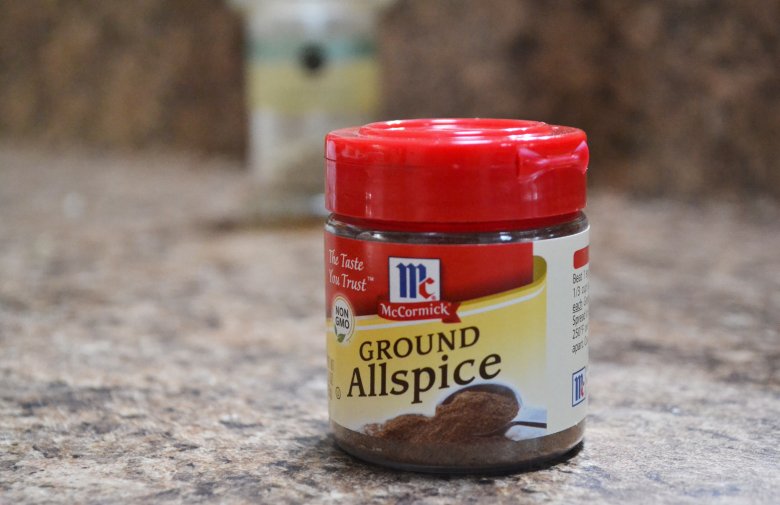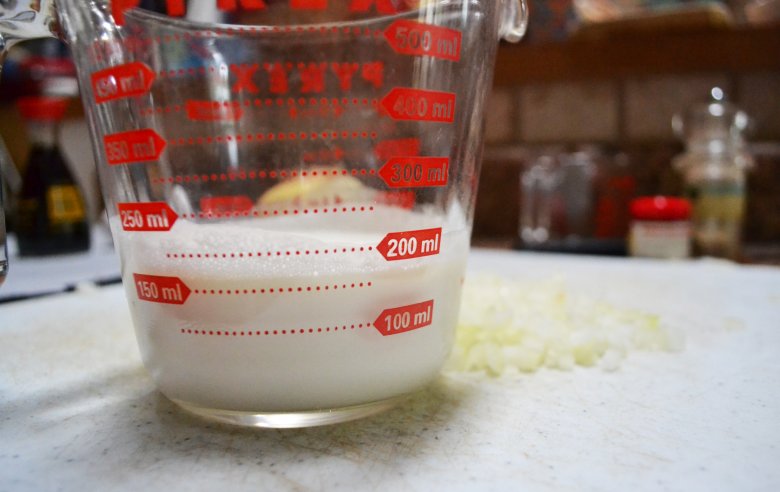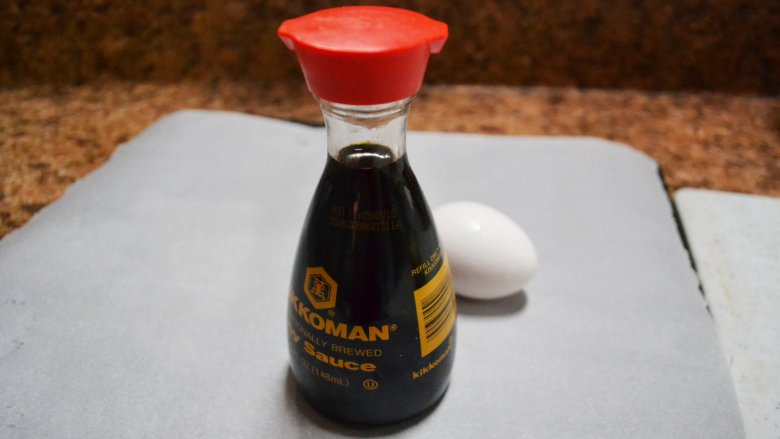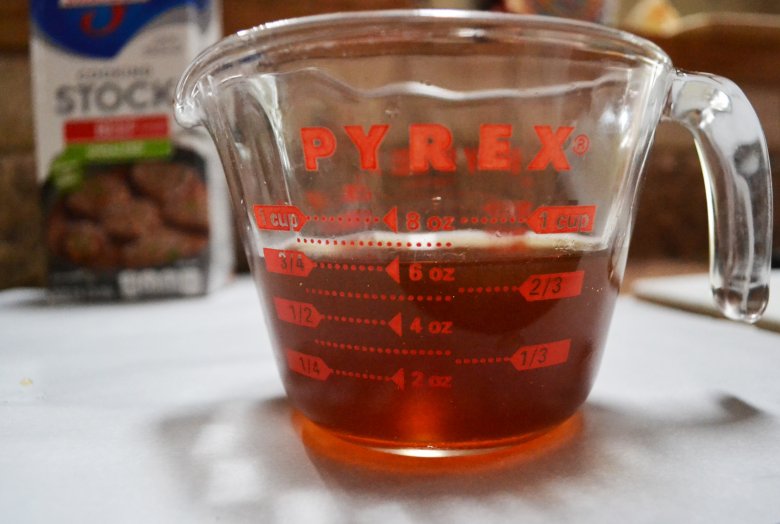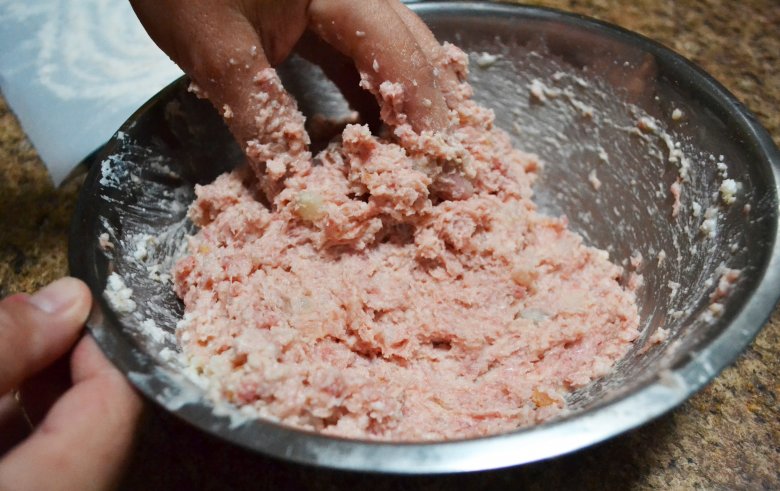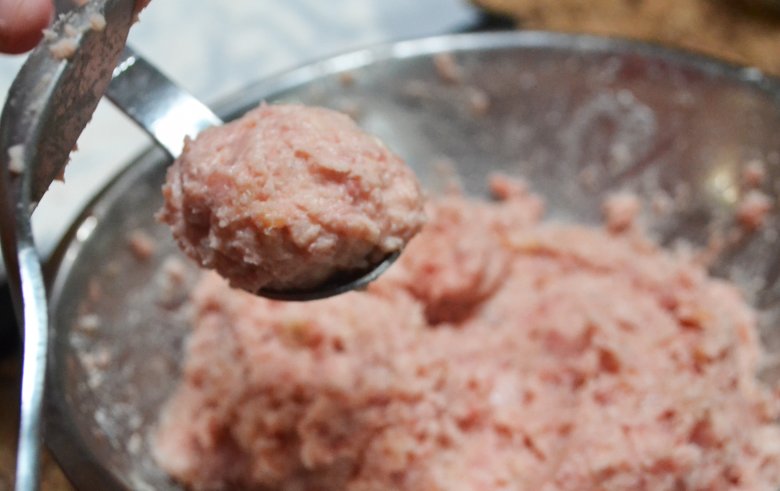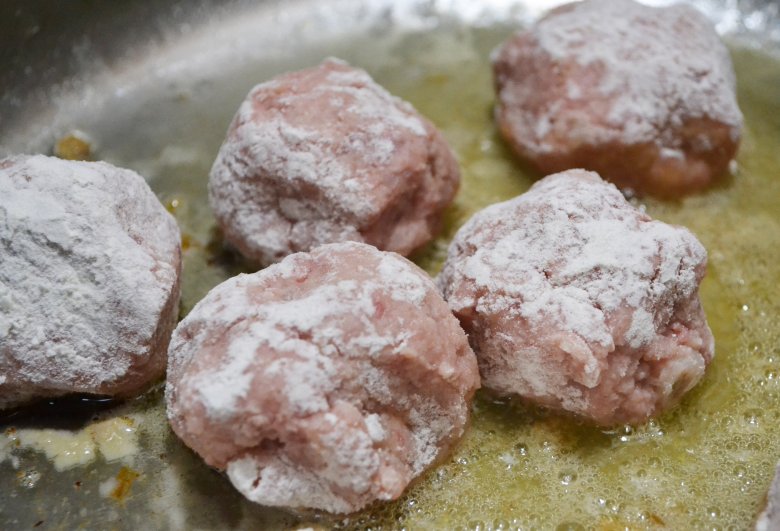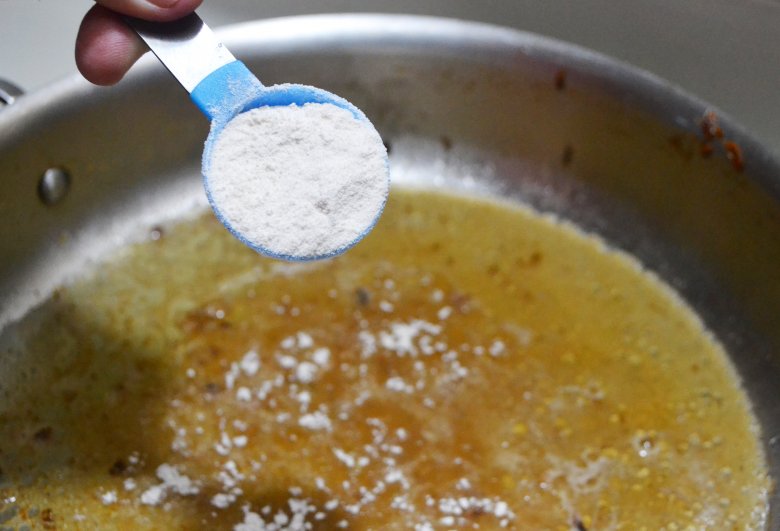Copycat IKEA Meatball Recipe
Who doesn't love a good meatball? But sometimes forgotten, and vastly underrated, is the Swedish meatball. There are actually variations of the meatball in Sweden — with the southern parts of the country generally favoring pork, and in the north they're straight up beef. The Swedish meatball has been popular in the US for years, but with the growth of IKEA and their Swedish food offerings, the Swedish meatball is no longer just something you pop in your microwave. IKEAs are slowly expanding in the US, but even if there's one near you, we don't all have the time or leg strength to walk three miles through the store just to get some meatballs. Can we make IKEA meatballs? You bet we can, and we're going to make them taste exactly like they do in the store — some assembly required.
Gather your ingredients
Here's what you need to make perfect IKEA Swedish meatballs: Ground beef, ground pork, one small onion, heavy cream, panko bread crumbs, a potato, butter, salt, white pepper, allspice, beef stock, soy sauce, and white flour. You'll get the full list of ingredients and step-by-step instructions at the end of this article.
What's going on here?
Behold, the IKEA Swedish meatball — all heated up and ready to eat. But what is that meatball, exactly? As mentioned, there are actually two different styles of meatball in Sweden, all-beef, and beef with more fat — which is in the form of pork. We'll be making the one with pork. IKEA kindly provides the exact recipe to make it yourself; aren't they so nice? Before you get too excited though, let me just tell you: It's wrong. Yep, I'm not saying they lied, I'm just saying that if you follow that exactly it won't taste anything like an IKEA Swedish meatball. How do I know? Well, keep on reading and figure out how the second attempt at making these came out.
The ball of meat
Like most standard meatballs, as mentioned the IKEA Swedish meatball is a mix of beef and pork. So head down to your local meat joint and pick up ground beef and ground pork. We're only going to need 250 grams each of them. Wait, what?
Only three countries are sensible enough to use pounds, so when you're working with a recipe that doesn't come from America, Liberia, or Myanmar, you need to convert things over to figure out what you need. A pound is 454 grams, so using a handy like conversion chart you'll need .55 pounds of meat each — basically a touch over a half pound each.
Potatoes?
The official recipe calls for two potatoes. Maybe Swedish potatoes, but a good old fashioned russet Potato is plenty — two of those will make the flavor overwhelmingly potato (trust me). So pare it back to just one russet potato, but if you'd like to use another kind, just make sure that it's equal to an average russet potato, which might mean two or three of whatever kind you're using. The variety of potato won't really matter in the final flavor, it's just more of a wet binder and a source of starch.
Boil one potato. As you can see I cut my potato(es) up when I boil them to make them cook a little faster — the smaller the pieces the better. The end product will be mashed anyway.
Onion
The official directions say to use 2 1/2 tablespoons of finely chopped onion. That equates to roughly a half of an onion or one small onion. "Finely chopped" is a relative term, but you want this small enough so you don't have chunks of onion floating in your meatball — the smaller you can get this the better. The onion needs to be "golden" but not caramelized, so your best bet in attacking this is to go with a "kinda sweat" as I call it. With some butter in the pan (Swedes love butter), start to heat that up but add the onion before you actually would to create a traditional fry — so it's not a sweat (starting from a cold pan to keep the onions opaque) but not blazing hot to make them turn color upon entry. Keep them moving and after a few minutes you'll see them slowly turn to a golden color without getting too dark. You're better off pulling them too soon rather than too late.
Unsweetened rusk flour?
Unsweetened Rusk Flour is the Naked Lunch of ingredients — none of those things come close to what they really are. What you really want here is breadcrumbs. There are ways to make your own rusk flour, but it's just breadcrumbs that are a little toasty. The popular way to go is panko; the Japanese breadcrumbs are available everywhere now and they'll do the trick for this meatball mix, and give us the toasty flavor and texture we're looking for.
All the spice
There's salt and pepper to give the dish a bit of flavor — although IKEA uses white pepper — which lacks the complexity of black pepper but has more heat to it. The other spice, which IKEA says is optional but come on... is allspice. That doesn't mean take all the spices from your rack and dump em in. Allspice is actually a berry picked before it's ripe and then ground into a fine powder.
Cream
The dairy is, according to IKEA: "cream (or milk)" — as if finding cream is some impossible task. You want to go the cream route here, and the cream you want is heavy cream. Depending on the nomenclature at your supermarket, it's "heavy whipping" or just "heavy" — but that's the one you want because the extra fats will give much more body to the finished sauce.
Soy sauce?
Sweden actually has a rich history with soy, with the first soybeans growing in the country by 1764. The soy is going to act more as a coloring device and a salty liquid than to actually bring an Asian flair to the dish. We won't need too much and as I always suggest, if you're monitoring your salt intake you can take it very easy with the soy sauce — or just skip it.
Beef stock
You can find them both next to each other in the grocery aisle; broth and stock. So what's the difference? Stock is from bones. We are using stock which is... well, beefier — because broth will have less protein than a stock — the bones and the marrow bring that extra boost and really give the sauce a hearty beef flavor.
The mix
Combine a half pound (or .55 pounds if you're precise like me) each of ground pork and ground beef, along with a single cooled potato, and the golden-browned onion. Add 1.6 ounces of bread crumbs or panko (moistened with three ounces of water water) and 7 ounces of heavy cream and then the spices — white pepper and allspice — about a half teaspoon each, along with as much salt (or as little) as your body can take, and get to mixing. The key is to get this as smooth as possible. Look, it isn't pretty, but I wanted to show you that image so if it starts looking like that you don't say, "Oh my God I just made Deviled Ham!"
Form the meatballs
After you have it smooth, use a couple of spoons to create a little over one-ounce meatballs, and set those aside. Think of it like you're knitting a sweater or folding your arms over like this guy does — basically after a few turns and a few meatballs you'll have it down pat.
Flour power
After you create the small meatballs, put them on a floured cutting board or plate and give em a roll. The flour acts twofold — it provides a little crust around the outside and more importantly, it will keep the meatballs from falling apart or sticking to the bottom of the pan — hopefully.
Everybody in the simbassäng
(That's Swedish for swimming pool? Get it?) After you have your meatballs rolled in flour, exit those to a buttered pan and cook—as IKEA says—"quite slowly." What they're trying to say is "don't make them too brown" but they didn't have room to squeeze all that in. So shoot for a low-to-medium heat and keep them moving. It should take around 20 minutes to cook them up to IKEA's standards.
There's an old trick to not making meat stick and it'll come in handy here. Once you get the meatballs into the pan, give the pan a little shake to "roll" the meatballs around. It should create a small crust quickly on the balls, but not actually cook them to any degree. That will help a little so the meatballs won't be stuck and have you peeling your food apart. After they're cooked, exit them to a bowl and cover with plastic wrap or aluminum foil to keep them warm. It's time to make the sauce.
Sauce time
If you follow IKEA's directions exactly, you're going to end up with a fairly thin sauce. I make scratch Swedish meatballs a lot, and I prefer my sauces to be fairly thick and beefy. You can build this in the same pan in which you cooked the meatballs. Use a couple of ounces of beef stock to deglaze the pan, stirring it with a whisk to loosen up the beef parts and work the liquid around. This is where we're going to alter the official recipe a touch to get something a bit more flavorful.
Go ahead and add a tablespoon of white flour to create your roux, and as that comes together to a golden paste, add seven ounces of beef stock (which is about two ounces more than they say) and 3.3 ounces of cream, along with a drop of soy sauce. Keep that going with the whisk over medium heat. As it comes close to a boil, hit it with another tablespoon of flour and keep whisking. After that comes to a full boil, take it down to simmer and let that rest for about two minutes, occasionally stirring. Hit it with a couple good grinds of white pepper to bring the heat.
How close are we?
After we made a potato adjustment, the flavor came in remarkably close to the IKEA meatballs. In the original, you can pick up some onion, and you can certainly do that in the copycat version as well. The thing that really binds it together is the allspice; it's subtle, but that flavor works so well and because you can count the number of things that taste better frozen versus fresh on one hand, the perfect version really stands out as a very tasty meatball.
The adjustment to the flour and the stock also helped — the sauce presents as thicker and meatier and really rounds out the dish. If you went ahead and added in some lingonberry, it pairs perfectly with the sauce. This is a winner all around.

- ½ lb ground beef
- ½ lb ground pork
- 1 small onion or ½ onion equaling 2 ½ tablespoons
- 1.6 ounces panko (mixed with 3 o ounces of water)
- 1 boiled potato
- 5 tablespoons of butter
- Salt
- ½ teaspoon white pepper
- ½ teaspoon allspice
- 3.3 oz cream
- 8.7 oz beef stock, divided
- Soy sauce
- 1-2 tablespoons of white flour
- Peel and boil one potato.
- Mash and cool the potato.
- Place butter in a cool pan on low, and add onions when butter starts to melt. Bring the onion to a golden-brown color.
- Combine meat, onion, potato, and panko in a bowl. Mix well, then add allspice and white pepper.
- Mix that by hand until smooth.
- Use two spoons to shape the meat into approximately 1-ounce balls.
- Place balls on a floured cutting board or plate and evenly coat them.
- Place meatballs into a well-buttered pan over medium-low heat.
- Cook for approximately 20 minutes, turning the meatballs so they don't stick to the bottom.
- After cooking is complete, remove from the pan and cover to keep warm.
- In the same pan, add 2 ounces of beef stock to deglaze the pan, just enough to get everything loosened up.
- Add 1 tablespoon of flour to create a roux.
- As the roux comes together, add 6.7 ounces of beef stock and 3.3 ounces of cream, stirring continuously.
- Bring to a boil over medium heat, and just before it begins to bubble, add 1 ounce of flour and whisk it in.
- Bring to a boil again and just as it hits, reduce the heat to a simmer and add a couple of good grinds of white pepper.
- Simmer for two minutes.
- Serve meatballs with the sauce and a side of lingonberry and enjoy!
| Calories per Serving | 81 |
| Total Fat | 6.3 g |
| Saturated Fat | 3.1 g |
| Trans Fat | 0.2 g |
| Cholesterol | 20.2 mg |
| Total Carbohydrates | 3.1 g |
| Dietary Fiber | 0.3 g |
| Total Sugars | 0.3 g |
| Sodium | 93.6 mg |
| Protein | 3.2 g |

